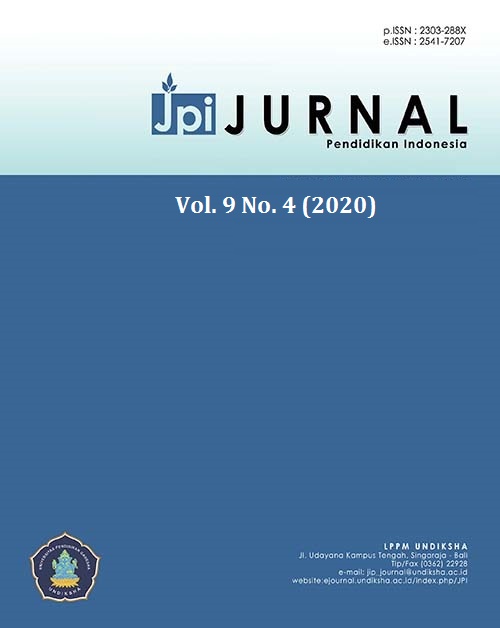Learning Style Preference: Results of Repetitive Cross-Sectional Surveys in an Higher Education Institution
DOI:
https://doi.org/10.23887/jpi-undiksha.v9i4.21414Keywords:
learning styles, innovation in teaching, quality, management, higher education, teaching-learning methodologiesAbstract
Using the theoretical framework of the Felder-Silverman Learning Styles Model, this study aims to understand the learning styles of middle school students entering the university to promote teaching innovation and improve the quality of the learning experience. A quantitative research method was applied through repeated cross-sectional surveys for 3 years among 2,325 students. Systematic analysis is applied to investigate respondent learning styles. Data analysis showed a significant difference in terms of the sex of students, while in terms of graduation years, the proportion of sequential students showed a significant increase from 2014 to 2016; this might imply that students from scientific or analytic backgrounds increasingly choose management schools. As expected, management students are active in character, except in accounting programs, where sensing learners are dominant. Innovative, active and visual-based learning is also preferred. Through the findings of this study, we conclude that interest in studies is related to the learning dimensions. The teaching style must follow the characteristics of the learning dimensions to provide an optimal learning experience. Here, it is important to implement an innovation-based learning process in higher education institutions.
References
Adedeji, S. B., Rahman, M. M., Abdul, M. B., Ghani, M. F. B. A., Uddin, M. J., & Rahaman, M. S. (2020). Innovative Teaching Methods and Entrepreneurship Education: a Synthesised Literature Review. Educational Administration Research and Review, 2(1), 1807–1813. https://doi.org/10.17509/earr.v2i1.21713
Al Shaikh, A., Aldarmahi, A. A., AL-Sanie, E., Subahi, A., Ahmed, M. E., Hydrie, M. Z., & Al-Jifree, H. (2019). Learning styles and satisfaction with educational activities of Saudi Health Science University Students. Journal of Taibah University Medical Sciences, 14(5), 418–424. https://doi.org/10.1016/j.jtumed.2019.07.002
Bayrak, B. K. (2012). A Study on Learning Styles of Secondary School Student’s According to Gender and Class Level. Procedia - Social and Behavioral Sciences, 46, 843–847. https://doi.org/10.1016/j.sbspro.2012.05.210
Bernardes, R. F., Guzzo, R. F., & Madera, J. M. (2019). Millennial Attitudes Toward Online and Traditional Training Methods: The Role of Training Utility and Satisfaction. Cornell Hospitality Quarterly, 60(4), 320–334. https://doi.org/10.1177/1938965519843488
Chimmalgi, M. (2018). Off-line virtual microscopy in teaching histology to the undergraduate medical students: do the benefits correlate with the learning style preferences? Journal of the Anatomical Society of India, 67(2), 186–192. https://doi.org/10.1016/j.jasi.2018.11.010
Dilullo, C., Mcgee, P., & Kriebel, R. M. (2011). Demystifying the Millennial student: A reassessment in measures of character and engagement in professional education. Anatomical Sciences Education, 4(4), 214–226. https://doi.org/10.1002/ase.240
Hussain, N., & Ayub, N. (2012). Learning Styles of Students and Teaching Styles of Teachers in Business Education: A Case Study of Pakistan. Procedia - Social and Behavioral Sciences, 69(Iceepsy), 1737–1740. https://doi.org/10.1016/j.sbspro.2012.12.122
Islam, N. (2019). Learning Styles : Diverse Avenues to Learning. International Journal of Research in Engineering, IT and Social Sciences, 09(01), 73–85. http://indusedu.org/pdfs/IJREISS/IJREISS_2609_75966.pdf
Lee, J. X., Hathim, A., Azman, A., Ng, J. Y., & Shareela, N. A. (2020). Reflection of connectivism in medical education and learning motivation during COVID-19. MedRxiv. https://doi.org/https://doi.org/10.1101/2020.07.07.20147918
McKenna, L., Copnell, B., Butler, A. E., & Lau, R. (2018). Learning style preferences of Australian accelerated postgraduate pre-registration nursing students: A cross-sectional survey. Nurse Education in Practice, 28(January), 280–284. https://doi.org/10.1016/j.nepr.2017.10.011
Nightingale, R., Wirz, L., Cook, W., & Swallow, V. (2017). Collaborating With Parents of Children With Chronic Conditions and Professionals to Design, Develop and Pre-pilot PLAnT (the Parent Learning Needs and Preferences Assessment Tool). Journal of Pediatric Nursing, 35, 90–97. https://doi.org/10.1016/j.pedn.2017.03.008
Putri, F. E., Amelia, F., & Gusmania, Y. (2019). Hubungan Antara Gaya Belajar dan Keaktifan Belajar Matematika Terhadap Hasil Belajar Siswa. Edumatika: Jurnal Riset Pendidikan Matematika, 2(2), 83. https://doi.org/10.32939/ejrpm.v2i2.406
Rivas, A., González-Briones, A., Hernández, G., Prieto, J., & Chamoso, P. (2021). Artificial neural network analysis of the academic performance of students in virtual learning environments. Neurocomputing, 423(xxxx), 713–720. https://doi.org/10.1016/j.neucom.2020.02.125
Sakti, T. K., Hairunisya, N., & Sujai, I. S. (2019). Pengaruh Kompetensi Pedagogik Guru dan Gaya Belajar Siswa Terhadap Prestasi Belajar Siswa Pada Mata Pelajaran IPS. Jurnal Pendidikan Ilmu Sosial, 28(1), 53. https://doi.org/10.17509/jpis.v28i1.12818
Sundayana, R. (2018). Kaitan antara Gaya Belajar, Kemandirian Belajar, dan Kemampuan Pemecahan Masalah Siswa SMP dalam Pelajaran Matematika. Mosharafa: Jurnal Pendidikan Matematika, 5(2), 75–84. https://doi.org/10.31980/mosharafa.v5i2.262
Utami, P. S., & Gafur, A. (2015). Pengaruh Metode Pembelajaran Dan Gaya Belajar Siswa Terhadap Hasil Belajar IPS Di SMP Negeri Di Kota Yogyakarta. Harmoni Sosial: Jurnal Pendidikan IPS, 2(1), 97–103. https://doi.org/10.21831/hsjpi.v2i1.4622
Downloads
Published
Issue
Section
License
Authors who publish with the Jurnal Pendidikan Indnesia agree to the following terms:
- Authors retain copyright and grant the journal the right of first publication with the work simultaneously licensed under a Creative Commons Attribution License (CC BY-SA 4.0) that allows others to share the work with an acknowledgment of the work's authorship and initial publication in this journal.
- Authors are able to enter into separate, additional contractual arrangements for the non-exclusive distribution of the journal's published version of the work (e.g., post it to an institutional repository or publish it in a book), with an acknowledgment of its initial publication in this journal.
- Authors are permitted and encouraged to post their work online (e.g., in institutional repositories or on their website) prior to and during the submission process, as it can lead to productive exchanges, as well as earlier and greater citation of published work. (See The Effect of Open Access)








